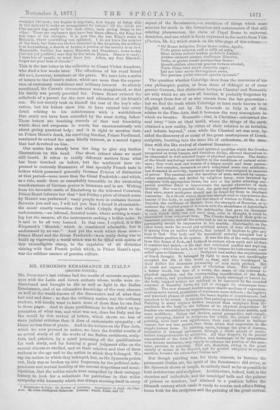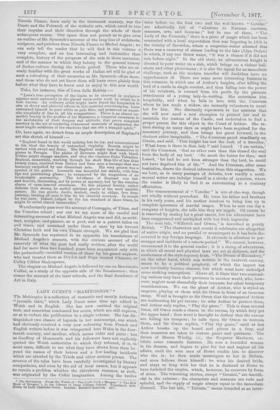MR. SYMONDS'S RENAISSANCE IN ITALY.* [SECOND NOTICE.)
Mn. SYMONDS'S last volume had the merits of accurate acquaint- ance with the Latin and Greek authors whose works were re- discovered and brought to life as well as light in the Italian Renaissance, and of an exhaustive knowledge of the very obscure as well as the world-known of the discoverers and of what they had said and done ; so that the ordinary reader, nay the ordinary student, will hardly want to learn more of them than he can find in those pages. And to these qualifications he has added an ap- preciation of what was, and what was not, done for Italy and for the world by this revival of letters, which shows no less of stern judicial criticism than it does of enthusiastic sympathy ; of blame no less than of praise. And in the volume on the Fine-Arts, which we now proceed to notice, we have the fruitful results of an actual study of all the works of the Italian architects, sculp- tors, and painters, by a mind possessing all the qualifications for such study, and for forming a good judgment alike on the several objects so studied, and on their relation and that of their authors to the age and to the nation to which they belonged. We say the nation to which they belonged, but, as Mr. Symonds points out, Italy was so broken up into fragments by the political inde- pendence and mutual hostility of the several despotisms and muni- cipalities, that the nobler minds were compelled by their unhappy history to look for a substitute for patriotism in that wider sympathy with humanity which was always showing itself in every • Renaissance in Italy: the Revival of Learning. Renaissance in They: the Fine- Arre. By John Addiagion Symonds. London: Salida, Elder, and Co.
aspect of the Renaissance,—a condition of things which must account for much in the formation and maintenance of that still existing phenomenon, the claim of Papal Rome to universal dominion, and one which is finely expressed in the motto from Vida (Poetica, lib. ii.) which stands on the title-page of this volume :—
‘, Dii ROMEO indigetes, Trojte tuquo cultor, Apollo,
Undo genus nostrum mil se tollit ad astra, Hama saltem auferri laudem prohibete Latinis Artibus emineat temper, studiisque Minervaa, Italia, et gent.% docent puleherrima Roma : Quandoquidem armorum penitus fortuna remelt, Tanta 'taloa inter orevit disoordia regea ; Ipsi nos inter Hawes distringimus enses, Nee patriam pudet externis aporire tyrannis,"
The question whether Coleridge drew from the resources of hie
own philosophic genius, or from those of Schlegel or of some greater German, that distinction between Classical and Romantic art with which we are now all familiar, is probably forgotten by all except those few of us who remain from the last generation but we find the truth which Coleridge at least made known to us, English worked out by Mr. Symonds so fully in all that relates to the Fine-Arts, that it becomes the very atmosphere in which we breathe. Romantic—that, is Christian—art carried the soul away "into an ideal world, where the things of the earth obtained a new reality, by virtue of their relation to an invisible and infinite beyond," even while the Classical art was now, by aidof the discovery of so many of the great masterpieces of Greek sculpture, bursting into the same life of enthusiasm, at the same time with the like revival of classical literature :— " In ancient art, those moral and spiritual qualities which the Greeks recognised as truly human, and therefore divine, allowed themselves to be incarnated in well-selected types of physical perfection. The duties. of the Greek mythology were limited to the conditions of natural exist- once; they were men and women of a larger mould and freer person- ality ; less complex, inasmuch as each completed some one attribute t. less thwarted in activity, inasmuch As no limit was assigned to exercise of power. The passions and the faculties of man, analysed by uncon- scious psychology, and deified by religious fancy, wore invested by sculpture with appropriate forms, the tact of the artist selecting cor- poreal qualities fitted to impersonate the special character .of eaah, divinity. Nor was it possible that, the gods and goddesseshemg what they were, exact analogues should not be found for them in idealised humanity. In a Greek statue there was enough soul to characterise the
of the body, to render her due mood of wisdom to Pallas, to dis- tinguish the swiftness of Hermes from the strength of Horacles, or to. contrast the virginal grace of Artemis with the abundance of Aphrodite's charms. At tho sumo flub, the spirituality that gave its character to each Greek deity was not such that, even in thought, it could be dissooiated from corporeal form. The Greeks thought of their gods as incarnate persons, and all the artist had to see to was that this incarnate- personality should be impressive in his marble. Christianity, on the other hand, made tho moral and spiritual nature of man all-essential. It sprang from an earlier religion, that judged it impious to give any form to God. The body and its terrestrial activity occupied but a subordinate position in its system. It was the life of the soul, separable. from this frame of flesh, and destined to endure when earth and all that it contains had ended,—a life that was continued conflict and aspiring
struggle,—which the arts, in so fasrotiaslyttlitie they became iittesdinthste irrruemqountesm, were
called upon to illustrate
of Greek thought. It belonged by right to men who not unwillingly accepted the life of this world as final, and who worshipped in• their deities the incarnate personality of man made perfect. But it could not express the cycle of Christian ideas. The desire of a better world, the fear of a worse, the sense of sin referred to physical appetites, and the corresponding mortification of the flesh,, hope, ecstaey, and penitence and. prayer, imply contempt or hatred for the body, suggest notions too spiritual to be conveyed by the rounded contours of beautiful limbs, too full of struggle for statuesque tran- quillity. The now element needed a more elastic medium of expression,. motives more varied, gradations
ns of sentiment more delicate ; the fugitive and transient phases of emotion, the inner depths of consciousness, had somehow to be seized. It was here that painting assorted its supremacy. Painting is many degrees farther removed than sculpture from de- pendence on the body in the fullness of its physical proportions. It touches our sensibilities by suggestions more indirect, more mobile, and, more multiform. Colour and shadow, aerial perspective and oompli- catod grouping, denied to sculpture, but within tho proper realm of painting, have their own
significance, thwehirichreafilndreleaxtipornesstioonfeienlinthges vaguer, but not less potent, than those
simple human form. To painting, again, belongs the play of feature, of thesspec-.
c
indicative of internal movement, through a whole gamut of modu- lations inapproliensible by sculpture. All that drapery, by its partial'
passion b. y its
concealment of the form it
seil;t111,48'tolinendhanlancdestchaepe
with human sentiment, may disposal, arid its greater adequacy to express tater, pertains to painting. This art,. therefore, owing to the groat variety of moans at its
was, for these reasons, to become the emotion, became the paramount Italian art.' But though painting
paramount Italian art, the spirit of the Renaissance did strive, as Mr. Symonds shows at length, to embody itself as far as possible in both architecture and sculpture. Architecture, indeed, both in the churches and cathedrals, and the municipal halls and the palaces of princes or senators, had attained to a position before the fifteenth century which made it ready to receive and offer a fitting home both for the sculpture and the painting of the great revival. Niecela Pisan°, born early in the thirteenth century, was the Dante and the Petrarch of the a3sthetic arts, which owed to him their impulse and their direction through the whole of their subsequent course. Our space does not permit us to give even an outline of Mr. Symonds's account of the long line of architects, sculptors, and painters from Niccola Pisan° to Michel Angelo ; we can only tell the reader that he will find in this volume a very complete, and no less interesting and instructive than complete, history of the progress of the arts in these centuries, and of the manner in which they belong to the general history of Italian culture during the whole period. Those who are al- ready familiar with the great works of Italian art will be glad of such a refreshing of their memories as Mr. Symonds offers them, .and those who do not yet know them will learn more plainly than before what they have to know and to enjoy in this new world.
Take, for instance, this of Luca della Robbia :—
" Luca's true perception of the limits to be observed in sculpture appears most eminently in the glazed terra-cotta work by which he is best known. An ordinary artist might have found the temptation to aim at showy and pictorial effects in this material overwhelming. Luca restrained himself to pure white on pale blue, and preserved an exqui- site simplicity of lino in all his compositions. There is an almost un- earthly beauty in the profiles of his Madonnas, a tempered sweetness in the modulation of their drapery and attitude, that prove complete mastery in the art of rendering evanescent moments of expression, the most fragile subtleties of the emotions that can stir a tranquil spirit."
Or, here again, we detach from an ample description of Raphael's art this sketch of himself :-
"Raphael found in this world nothing but its joy, and communicated to his ideal the beauty of untouched virginity. Brescia might be sacked with sword and flame. The Baglioni might hew themselves to pieces in Perugia. The plains of Ravenna might flow with blood. Urbino might change masters, and obey the viperous Duke Valentino. Raphael, meanwhile, working through his short May-life of less than twenty years, received from Nature and from man a message that was 2farmony unspoiled by one discordant note. His very person was a symbol of his genius. Leonardo was beautiful but stately, with firm lips and penetrating glance ; ho conquered by the magnetism of an Incalculable personality. The loveliness of Raphael was fair and flexible, fascinating, not by power or mystery, but by the winning charm of open-hearted sweetness. To this physical beauty, rather delicate than strong, he united spiritual graces of the most amiable nature. He was gentle, docile, modest, ready to oblige, free from jealousy, binding all men to him by his cheerful courtesy. In morals the was pure. Indeed, judged by the lax standard of those times, he might be called almost immaculate."
We reluctantly pass over the account of Correggio, of Titian, and the Venetian school ; nor can we say more of the careful and interesting account of what Michael Angelo was and did, as archi- tect, sculptor, and painter, as a poet, and as a patriot fallen on 'evil times, and sustained under them at once by his fervent Christian faith and his own Titanic strength. We are glad that Mr. Symonds has reprinted in an appendix his translations of Michael Angelo's sonnets, with the curious account of the 'recovery of what the poet had really written, after the world Lad for more than two hundred years been acquainted only with the pedantically-emended version of them by his grand nephew, who had treated them as Dryden and Pope treated Chaucer, or Colley Cibber Shakespeare. The chapter on Michael Angelo is followed by one on Benvenuto
Cellini, as a study of the opposite side of the Renaissance ; then 40131013 the account of the later schools, and the final decadence of Art in Italy.



































 Previous page
Previous page